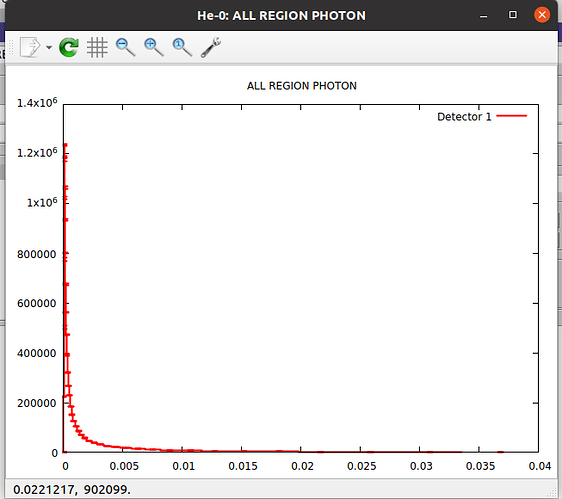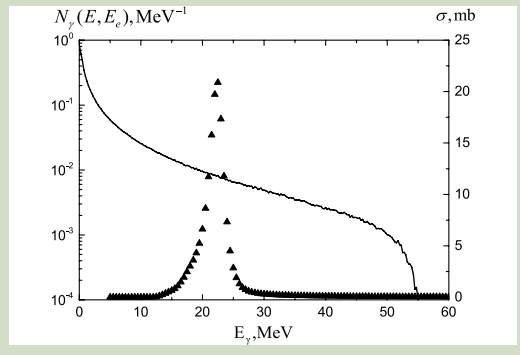Hi, expert. I am a beginner FLAIR. I calculated the yield of electrons bombarding Ta targets to produce photons, and then photons bombarding Zn-68 to produce Cu-67, but my yield sometimes does not produce, and the calculation error is also large. Can you help me see what the problem is? Thank you very much!
Zn.inp (2.9 KB)
Hi @xzy66
Thank you for the question. First of all, from what your write:
but my yield sometimes does not produce, and the calculation error is also large.
it seems that you should greatly increase the number of primaries in your simulation. I can see in your FLUKA file that you are dealing with quite low primary energy (40 MeV electrons) so I checked the spectrum of photons in your ZN region by adding the following card:

and it looks like the photon energies are mostly below 1 MeV range so the vast majority of these photons will not be able to induce photo-nuclear reactions. Therefore, biasing should be used to see some reasonable statistics.
However, I think the LAM-BIAS card that you introduced might not be doing what you expect. I decided to substitute it with the two following cards

where the first one reduces the photon inelastic interaction length inside the Zn material by a factor of 100 and the second decreases the PRIMARY electron inelastic interaction length by a factor of 50 in your TITANIUM material.
I tried to run 50e6 primaries and I managed to see some activation in the ZN region.
Let me know if that helps.
Cheers,
Jerzy
Hi,expert!
I’m sorry, I’ve been a little busy recently. You just saw your message today!
First of all, I observed the generation of 67 copper after the increase of the simulated primaries , but it was several times lower than the results in the literature, even tens of times, which I did not expect; Then, after I added the LOW-BIAS, although 67 copper was generated, the photon energy still did not change much , which I think should be the reason why the result is too low,as shown in FIG
According to the literature I have consulted, the flux of photons should be a slow declining process, as shown in Figure
Secondly, the photoproton reaction of 68Zn to 67Cu should have a reaction threshold of about 9MeV, so I set the photon cutoff energy to 3*10-5 through EMFCUT card, and then set the prompt cut to 3000 through RADDECAY, so as to reach the photon reaction threshold of about 9MeV. I don’t know if this setting is correct.I compared the cases without this setting and found that the results did not change, whether FLUKA had considered the problem of reaction threshold.
Finally, I changed some input parameters for some personal reasons, but this does not change the problem I am facing. The input file is as follows
Zn.inp (3.4 KB)
Thank you very much!
Cheers,
zhiyu xu
Respected @jemancza
Recently, I saw other teachers discussing in the forum that the photoproton reaction in FLUKA will be two to three times lower than the experimental measurement, I wonder if there is any documentation.
Sorry to bother you. We are looking forward to hearing from you soon!
Thank you very much!
Cheers,
zhiyu xu.
Hi @xzy66
I assume that you are referring to the following thread:
where indeed the cross section for photonuclear reaction of 68Zn to 67Cu was reported to be lower. This was the case for FLUKA v4-1. However, it seems that this particular discrepancy could still be there in the current version as I did not find any direct mention in the release notes of any of the newer versions up to the current v4-5.
About the plots that you are showing - I think that it’s hard to compare the spectra if you are using different scales, try putting a logarithmic scale on the plot that you are producing and then compare with your reference.
The other thing is that for what you are trying to obtain, you don’t really need the RADDECAY card. It is only necessary when you want to look at residual dose/isotopes after a certain cooling time. Following this remark, I think that you should not set DCYSCORE for your RESNUCLEI cards as, if I understand correctly, what you are really trying to see is the prompt production of 67Cu.
I tried to run FLUKA with the input file that you provided (I just increased the number of bins in USRTRACK cards and added one more) and I can clearly see a cut-off at 9 MeV in the photon spectra as the minimum energy registered. Then, if the reaction threshold is also 9 MeV, then you would not really see much difference in the photoproduction of 67Cu.
Let me know if you have any other questions.
Cheers,
Jerzy
Respected @jemancza
First of all, thank you for your reply. If the reaction cross-section built into FLUKA is too low, then is there any way to correct the calculation process to make the calculation result higher? Because I want a better match with the literature.
Secondly, while I am concerned about the specific activity, I also care about the deposition of energy on the target, so as to add an appropriate cooling flow rate to the target. Select “energy” through the USRBIN card to observe the deposited energy, plot 21 bins, export and sum the two-dimensional graph data, then multiply by 0.010.013 (the two-dimensional volume of the divided bins) to obtain the energy deposition of one electron on the entire region.
Then multiply by 1.602176634×10^-10 (GeV converted to joules), and finally multiply by the beam intensity, that is, how many particles are incident per second (for example, 1mA=6.25 ×10^ 15 particles per second), to obtain the power deposition per second under 1mA beam condition (unit W). I want to know if my calculation approach and the way of observing energy are correct?
As for the RADDECAY card, I do need it. In my subsequent work, I need to observe the change in material activity with irradiation time. I think adding it will not affect the accuracy of the calculation, so I will keep it all the time.
Finally, I calculated different values when setting PROMPT CUT=0 and 3000 through RADDECAY. The larger the CUT value, the greater the calculation result, and at the same time, the smaller the calculation time (CUT=3000, especially for energy deposition, it is almost twice as large). Is this because photons or electrons immediately deposit energy within the material when they reach the cut-off energy? If I have any questions about my understanding, could you give me some suggestions on the Settings?
Thank you!
Looking forward to your prompt reply!
Note that we are not talking about the reaction cross section (68Zn(g,*)), rather the cross section of the specific channel 68Zn(g,p), which amounts to only few percent of the reaction cross section.
An improvement (i.e., increase) of the simulated value requires us to adjust the FLUKA reaction model, which has more general consequences to be properly validated, and is on our developments’ list.
Respected @ceruttif
Thank you for your reply. I understand your meaning on this issue. I would like to continue asking questions about energy. I would be very grateful if you could answer them!



